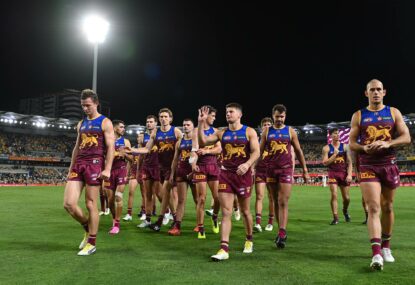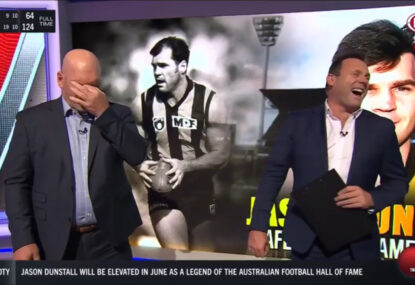In 1908, two teams were invited to join what had become the premier professional football league in Australia the old Victorian Football League, predecessor of the modern AFL.
One was the Richmond Tigers, which now has over a century of history in the VFL/AFL, including ten titles.
The other was a group of amateur players from Melbourne University. They were the only amateurs in the league (officially; payment in the good ol’ days was notoriously vague in the leaner years), consisting solely of MU students throughout their seven-year tenure in the VFL.
According to some research done by Daniel Cherny from the Age a few years ago in the school history Black and Blue, in one particular game in 1909, “the team that took on Collingwood (had 13 members who) were either medical students or qualified doctors”.
Not your average footy team, then.
The University stopped putting a team on the VFL schedule after the 1914 schedule, not because they were running on a 51-game losing streak at the time, but for a much more important reason: World War One.
University literature says that 251 students and graduates of Melbourne University were killed in the war, at least nineteen of whom had suited up for University on the pitch. When they were unable to field a team for the 1915 season, they “folded” as a professional presence.
While the team remained a viable amateur club both before and after their VFL stint (and both the Uni Blues and the Uni Blacks still compete successfully in the Victorian Amateur Football Association), it’s the seven year period between 1908 and 1914 that we’re interested in, the lifespan of the only team in VFL/AFL history ever to go completely dark (Fitzroy lives on within the Brisbane Lions, even if their team records are no longer “live”).
The University “Students” (not the most dramatic mascot, but perhaps the most accurate in history!) flipped the usual “expansion” scenario on its head when they entered the VFL. In their first three seasons, they finished sixth and seventh in a ten-team league, going 25-27-2 over the course of 1908-10.
And then, the bottom dropped out.
Over the course of their final four seasons, the University VFL team went 2-70. That is not a typo. They won twice in four years, once in R3 of 1911 (53-41 over Richmond), and again in R3 of 1912 over Richmond (63-48 this time), with a full season losing streak (18 games) in between.
What University fans would soon call “a nice warm-up”.
From that second Tiger defeat on, the Students would never win another VFL game. 15 more losses in 1912, and two seasons of 0-18 the next two years would add up to a 51-game losing streak which will probably never be approached, let alone broken.
Its only competition came from the birth pangs of the St Kilda footy club in 1897, a team which took almost three (shorter) seasons to win its first game in late 1899 (against Geelong).
Although the Saints would run off another pair of double digit streaks in the next couple of seasons (27 losses starting the next fall in 1900 and a 23-gamer following that, beginning in mid-1901), they never again approached the sheer consistency of that losing streak.
No other team has come within about a season of University’s streak, North Melbourne of the early 1930s being the next closest contender (by the way, the two most recent expansion franchises each had 21-game losing streaks early in their existence, and are the longest such streaks in the 21st century. GWS now shares the all-time record for consecutive draws, however, with two; a streak which may never be broken).
Such was the quality gap between University and the rest of the VFL that the 1914 ladder had some really bizarre idiosyncrasies.
Eight of the ten teams had percentages above 100. Meanwhile, poor University was 0-18 with an incredible 47.0 percentage, with the Melbourne Demons having a similarly poor season for actual professionals, going 2-16 with only a 61.3 percentage.
Guess which team the Demons managed to beat twice.
If you took away Melbourne’s two victories against the amateurs from MU, their record would have been 0-16 with just a 53.4 percentage, a percentage “beaten” by only a dozen or so teams in 120 years.
The other eight teams that year ranged from 8-10 with a 100.6 per cent on up to 14-4; five percentages were above 120, a figure not difficult to attain with four easy-beats on their 18-game schedule.
The 1914 University team still holds the claim for the worst single-season record in an 18-plus game season. Seven teams have gone winless at 0-18 (University holding two of those, as mentioned).
North Melbourne’s bad stretch in the early thirties produced two 0-18 seasons, in ’31 and ’34, with the former year’s percentage of 50.8 per cent placing them third worst all time (No team has lost every game in any format longer than 18 games – yet.)
Only Hawthorn’s 1950 club ever broke the 50 per cent barrier in a perfect 18-loss season, reaching 49.81 per cent by allowing eight more than double the number of points they scored themselves.
By comparison, the 1914 University squad gave up 103 more than double their own points scored (813-1729), for a percentage of 47.02 (the worst of St. Kilda’s 0-17 seasons came in 1899, where they rang up an abysmal 23.22 per cent, scoring only 40 goals all season while allowing 192. In the inaugural 1897 season of 14 games, the Saints scored just 35 goals and went winless with a percentage of 29).
If you’re morbidly curious, there have only been two winless teams since the Second World War – that 1950 Hawks team and the 1964 Fitzroy club, also 0-18, which had a relatively robust percentage of almost 60 per cent.
The only four teams since the war to have duplicated University’s sub-50 per cent mark are 1950 Hawthorn (49.8), the last year of the fabled Fitzroy franchise, 1996 (one win and 21 losses with a percentage of 49.47, five goals below 50), the first year for Greater Western Sydney, in 2012 (somehow producing two wins alongside 20 losses and a percentage of 46.17), and the lowest post-war percentage ever, the 1-17 St. Kilda Saints of 1955, whose percentage of 45.4 represented an average game score of 105-48. In R11, they somehow defeated North by seven, 68-61. Fortunately for posterity, they then remembered who they were, and lost to Melbourne the next Saturday, 118-21.
Lastly, before I wander off, I took a quick look at the betting lines for the last six rounds of the season and projected where the 18 teams place if every one of those 54 games goes precisely as expected.
Here’s where they currently would land…
| 1. |
Adelaide |
(18-4-0) |
130% |
| 2. |
Geelong |
(16-5-1) |
116% |
| 3. |
GWS |
(15-5-2) |
117% |
| 4. |
Port Adelaide |
(15-7-0) |
129% |
| 5. |
Richmond |
(14-8-0) |
105% |
| 6. |
Sydney |
(13-9-0) |
115% |
| 7. |
Melbourne |
(13-9-0) |
107% |
| 8. |
Essendon |
(12-9-1) |
112% |
|
| 9. |
West Coast |
(12-9-1) |
105% |
| 10. |
Western BD |
(10-10-2) |
97% |
| 11. |
St Kilda |
(10-11-1) |
95% |
| 12. |
Hawthorn |
(9-12-1) |
88% |
| 13. |
Fremantle |
(8-14-0) |
83% |
| 14. |
Collingwood |
(7-15-0) |
96% |
| 15. |
Gold Coast |
(7-15-0) |
84% |
| 16. |
Carlton |
(6-16-0) |
83% |
| 17. |
North Melbourne |
(5-17-0) |
88% |
| 18. |
Brisbane |
(3-19-0) |
71% |
The biggest things to mention are that Essendon passed the Eagles after flipping the result of this weekend’s game versus the Saints, and Hawthorn picked up another game and a half in the oddsmakers’ eyes after their showing against the Cats Saturday afternoon.
Of course, if every game went precisely as expected the rest of the season, it wouldn’t be 2017, would it? So don’t throw away those betting cards from February just yet…



































































































